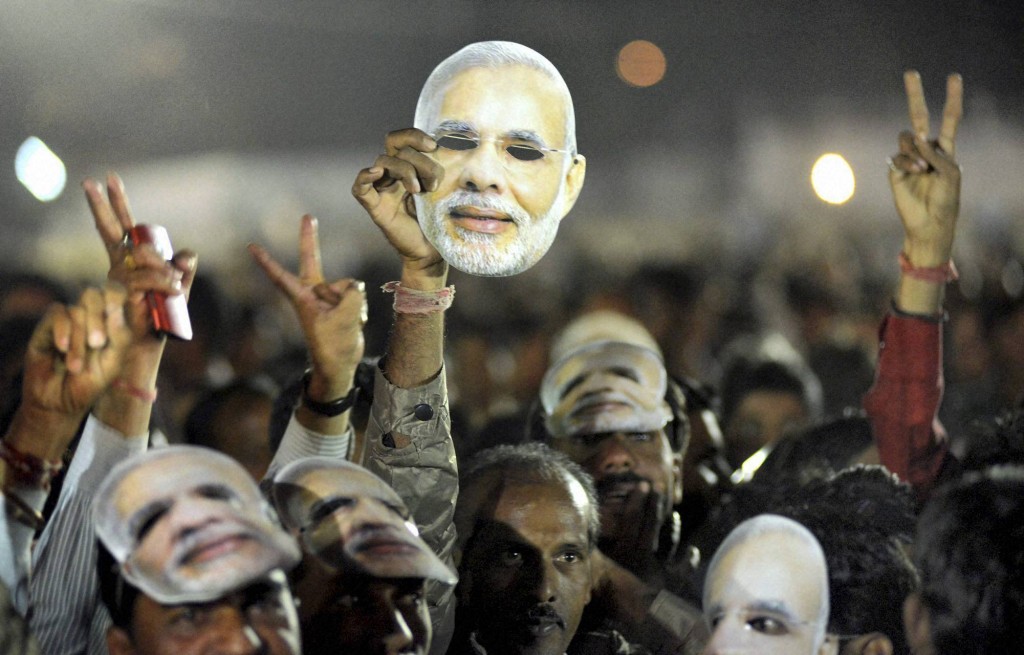PTI Photo, via The New Indian Express
In 2014, the year when Bollywood’s most popular ‘item’ song featured an Indo-Canadian porn star lip-syncing a song called ‘Baby Doll’, India elected a conservative Hindu chauvinist as its prime minister. Narendra Modi’s extraordinary ascent to power from humble party worker to a national icon of communal violence to hyper-efficient developmentalist leader is intriguing and revealing in itself, but let’s leave that aside for now.
The poll surveys and election data shows that the demographic most responsible for placing him in harm’s way came largely from young upper caste North Indian Hindus. Draw a line from Mangalore in the south-west to Darjeeling in the north-east – and with the exception of tiny pockets in Punjab and Kashmir, the saffron wave swept the vast majority of parliamentary seats to the north and west of that line.
Why did these people vote for Modi? Some did so because he is a muscular Hindutva bigot, a reputation heightened by his association with the worst anti-Muslim riots in India in two decades. Modi was Chief Minister of Gujarat during the 2002 riots, when senior members of his government, party, and their fraternal mass organisations led murderous attacks against Muslim neighbourhoods across Gujarat. The police and the remaining members of Modi’s administration who were not actually rioting stood limp and feigned strategic paralysis and ineptitude at their moment of greatest need.
Modi has personally denied any role in the riots, but his government has since 2002 actively and systematically obstructed the investigation and prosecution of those responsible. He has not admitted any guilt, and has found himself not responsible, either of criminality or of incompetence. He has also not expressed any contrition, not reached out to the victims, not expressed any sign of concern for them. And yes, the appalling truth is that many people in Gujarat and the rest of India adore him expressly because of this: because he is an unrepentant, chest-thumping bigot who taught a troublesome minority a lesson that they won’t forget.
But this isn’t everyone. Many others who were disturbed at the 2002 violence and found him repugnant then, came around over time to admire the man because of his reputation as a strong leader and an efficient administrator with a successful track record in development. Let me take you back for a second to the synchronised shaking of hips and the choreographed heaving of bosoms in the Baby Doll video (22 million hits on youtube). At one point, the star Sunny Leone, born Karenjit Kaur Vohra, mouths the pithy and vaguely profound lyrics in Punjabi: ‘yeh duniya pittal di … Baby Doll me sohne di’. In a world that is [dull as if it were] of brass, Baby Doll [shines as if she] is of gold.
Indeed, amidst the brassy, drab dullness of dysfunctionality that was Manmohan Singh’s India, Modi projected Gujarat as a gleaming land of gold: it is said to have clean roads, electricity, an efficient administration, and prosperity all around. Of course not all of Gujarat gleams, and not all that gleams is solid gold, but still, the myth prevails. India’s middle class, and a wider swathe of those who cling on to the threshhold of middle-classness turned to Modi because they are frustrated at the insipid progress in delivering the 21st century infrastructure and lifestyles that they believe is their due. They are exhausted at the corrupt misgovernance, and the succession of corruption scandals that rocked the UPA government. Finally, they are resentful of the politics of the poor, the lower castes, the special interests, and the minorities, and what they widely view as the wasteful, electorally motivated social expenditures that have been wasted upon them.
In contrast, Modi has offered them the tantalising vision of a Chinese path of development: fast-tracked infrastructure, smart technical solutions, authoritarian efficiency in dealing with the troublesome and unsightly. Under the banner of ‘patriotism’ and ‘development’, Modi presents a unifying vision that purports to transcend the special interest politics of caste, religion, and poverty that fragments and fractures India.
He also takes a no-nonsense approach to domestic and foreign security threats. In place of the inchoate mix of half-hearted carrots and sticks that has kept the insurgencies in central India or Kashmir burning without resolution for years, he has a simple securocratic answer: just say no. They will be dealt with as the Chinese deal with Tibetans, and the Israelis with the West Bank: overwhelming military force in the short-term, and demographic encirclement in the long-term.
Unlike the previous BJP governments of 1998-2004, Modi has no coalition partners to depend on and to moderate him or to limit the deeper foundational agenda that his saffron backers have long dreamed of. He has a full parliamentary majority to use and abuse at will, although constitutional changes are still beyond his reach. This new parliament itself is also worthy of mention: the 543 newly elected legislators in India’s lower house will be the wealthiest ever parliamentarians, with the largest ever number of members facing criminal charges, and featuring the lowest ever number of Muslims.
So therein lies the fate of India for the next five years – a legislature full of rich, criminal, Hindus, with an executive led by an authoritarian, pro-business, anti-Muslim bigot who is not shy of wasting a few thousand innocents here or there to make a point. As Modi said in his acceptance speech: Happy days are here to come! In the immediate afterglow of the victory, India’s legions of Modi supporters have filled the airwaves, media, and internet with euphoria at the solid gold they’ve finally struck. As for me, I’m just brassed off.
